Completed Research topics at the Professorship Power Transmission Systems
- Effectivity and interactions of various voltage control strategies for distribution grids
- Use of distributed generation for local island-system operation and accelerated network reconnection after large-scale blackout
- Integration of Electromobility in to the Power Grid
- Design, Dimensioning, Engineering and Control of Energy Distribution Networks characterized by a High Degree of Decentralized and Fluctuating Generation
- Decentralised regenerative electric power generation and its effect on the distribution network
- Grid connection of offshore- wind farms
- Local monitoring and improvement of network quality by means of power electronics and IT technologies
- Analysis of the impact of high photovoltaic feed in for better integration in medium and low voltage grids
- Dynamic Analysis in the German High Voltage Grid
Use of distributed generation for local island-system operation and accelerated network reconnection after large-scale blackout
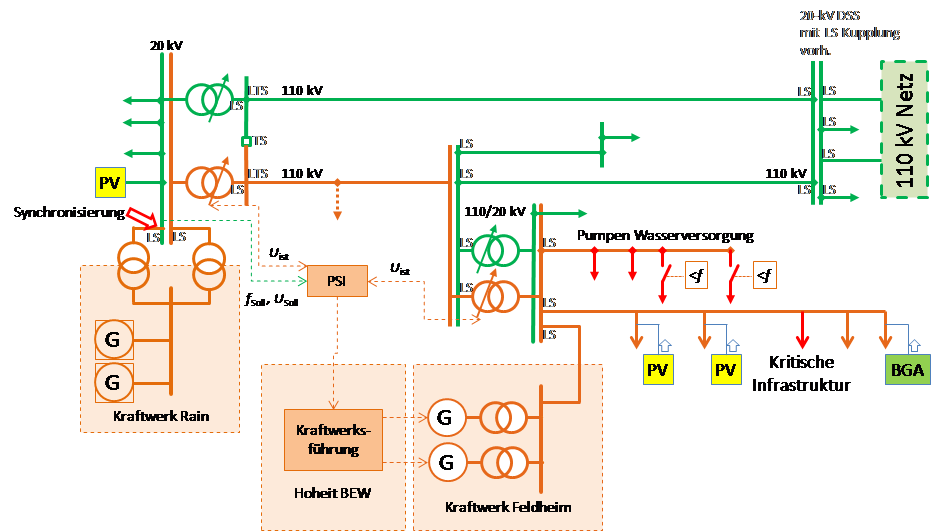
The effects of large-scale extended-duration blackouts represent a potential national catastrophe and threaten many of the essential services around which modern society is based. Through the operation of decentralized generation in island networks, critical services such as hospitals, fire services and police services could be maintained. The goal of the research project is the development of a generic scalable concept for stable island network operation utilizing decentralized generation, which is applicable to all voltage levels. Following the recovery of the main power system, the resynchronization and reconnection of the island network should be performed automatically without disturbance to grid operation.
Integration of Electromobility in to the Power Grid

In recent years research activity on electrical cars has increased drastically due to the scarcity of oil and the climate change. Electrical cars will be charged through the power outlet. This will lead to an increase of power consumption and present a new challenge for the power grid. The batteries of the electrical cars can help to even out the peak demand and congruence the energy generation and consumption. Electrical vehicles can also help to integrate renewable energies (e.g. photovoltaic systems) into the power grid. The Institute of Power Transmission Systems is researching on concepts on integrating electrical vehicles in to the power grid and analysing the influence this will have on the power grid.
Design, Dimensioning, Engineering and Control of Energy Distribution Networks characterized by a High Degree of Decentralized and Fluctuating Generation
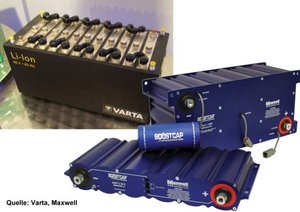
Due to governmental promotion there is a fast growing amount of decentralised power units in Germany. Especially the enormous feed-in of fluctuating electrical power in low-voltage grids caused by small-scale photovoltaic plants leads to a partially reverse power flow. In cases of increasing decentralised feed-in from photovoltaic power plants, transformers and cables can reach their loading limits. Moreover, the grid voltage can exceed permissible thresholds. It is not possible to integrate the entire potential of photovoltaic power plants in the low-voltage distribution grids at present. The distribution network has to be strengthened to increase the permissible feed-in of PV plants.
As an alternative the surplus electrical energy can be buffered locally. During periods of high load this energy is feed-back and leads to a more constant load profile. Also the use of the renewably produced electric power to substitute other primary energy sources (production of hydrogen, use in electric vehicles) may lead to a more balanced network load.
Decentralised regenerative electric power generation and its effect on the distribution network
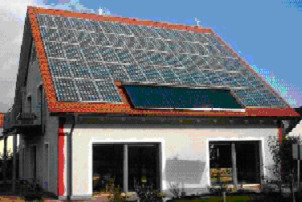
Renewable energies are in the focus of the European and German politics. The ratio of renewable energies on the overall electrical power consumption in Germany should be doubled till 2010 at 12.5%, till 2020 it should be more than 20%. Therefore governmental promotion has been established. In southern Germany there has been a boost on solar power generation. The preferred point of delivery of those solar generators is at low and medium voltage levels. This causes new tasks for building and operation of the electrical grid. We will to analyse the maximum load capacity of current power grids and determine optimisation potential of the systems.
Grid connection of offshore-wind farms

Since the adoption of the Infrastructure Planning Acceleration Act (17.12.2006), the German transmission system operators (TSO) are responsible for the provision of a transmission network to the transformer terminals of the planned offshore wind parks (OWP) in the North and Baltic Sea. In the North Sea more than 30 wind farms with different distances to the coast were planned with a total requested power of about 12,000 MW up to the year 2012. In the first stage of expansion a typical offshore wind park will consist of about 80 wind turbines, each with up to 5 MW.
The Institute of Power Transmission Systems will participate in the selection of appropriate technology and the development of an overall concept for the offshore transmission network.
Local monitoring and improvement of network quality by means of power electronics and IT technologies
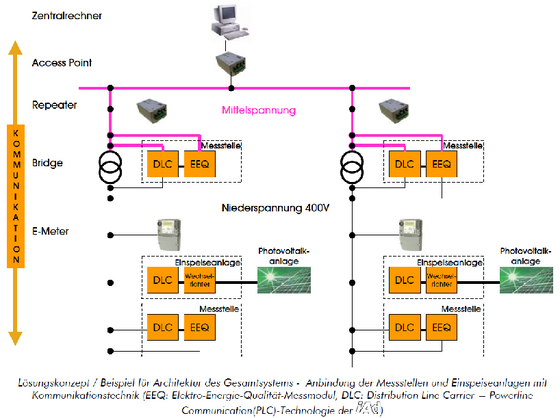
Increasing regenerative power sources installed in low voltage grids tend to cause overvoltage problems due to the reverse power flow direction. Consequently, regenerative sources need to be turned off temporarily and on the long term, the grid infrastructure would have to be extended by the utility company. Additionally, the increasing number of grid connected power electronic systems causes a high level of reactive power flow and harmonics in the grid affecting power quality. By means of an innovative communication and system concept the distribution network quality could be cost-effectively, locally and promptly monitored. Locally controlled inverters could contribute to improve the network quality by means of voltage stabilization, reactive power compensation and filtering/ compensation of harmonics. Thus, the capability to accept, integrate and transmit higher quantities of decentralised generated power can be improved.
Within the project NetzQ a corresponding device technology is developed and this approach will be tested exemplarily in two subnetworks (city, rural region).
Analysis of the impact of high photovoltaic feed in for better integration in medium and low voltage grids
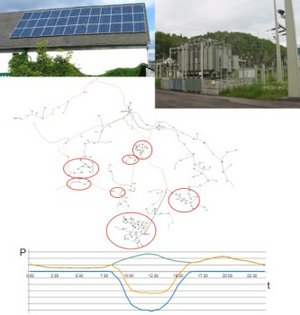
With the increasing number of decentralized power sources the network operator has to meet new challenges. The massive feed in of regenerative energy during times of light load inverts the original power flow from higher to lower voltage levels, for which the grid was designed.
In cooperation with the Hochschule München and e.on Bayern the research project “grid of the future” analyzes the state of a medium voltage grid including the subordinated low voltage grids with a high penetration of photovoltaic feed in. Measurements from intelligent electric meters installed at the feed in points and at the transformer stations will demonstrate the impact of decentralized and fluctuating electric power generation. These results will help to elaborate concepts for optimizing the grid with high feed in of renewable energies and to guarantee the usual security of energy supply.
www.eon-bayern.com/netz-der-zukunft
Dynamic Analysis in the German High Voltage Grid
The integration of renewable energy generation systems leads to an increasing replacement of rotating masses with power electronics. Furthermore in the future the power generation will be more and more decentralized. The existing transmission system in Germany is not designed for these changes. This might lead to stability problems. In order to evaluate the influence of power electronic converters and the decentralization of power generation on the system stability, the German transmission system has to be modeled and analyzed.